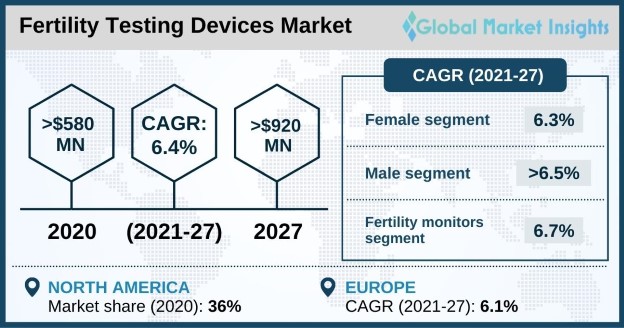Home > Healthcare > Medical Devices > Diagnostic Devices > Fertility Testing Devices Market
Fertility Testing Devices Market Size
- Report ID: GMI5129
- Published Date: Sep 2021
- Report Format: PDF
Fertility Testing Devices Market Size
Fertility Testing Devices Market Size exceeded USD 580 million in 2020 and will witness over 6.4% CAGR from 2021 to 2027. Increasing prevalence of infertility issues in adults due to sedentary and unhealthy lifestyle, growing awareness about family planning, and delayed first time pregnancy in women are some of the prominent factors that are expected to facilitate the market growth during the forecast timeframe. Moreover, popularity of self-assessing fertility test kits will further propel the market expansion. The impact of COVID-19 on the fertility testing devices business is observed to be moderate as in few parts of the world pregnancy amid pandemic rose and in some regions it declined.
Fertility tests are an essential part of fertility evaluation and treatment. Through fertility testing, one can possibly discover what's preventing them from achieving pregnancy. The fertility testing devices work by measuring hormonal levels of ones’ body and providing hormone profiles. These hormone profiles of the individuals are based on condition such as their cycle duration, any fertility disorder or on the basis of any drug or treatment taken by them. Few of fertility testing devices, such as fertility monitors give results by detecting high ovulating days by monitoring body temperature and other physiological factors. Fertility testing devices primarily include, ovulation kits, semen analysis kits and fertility monitors. The purpose of these kits is to detect information regarding sperm count in men, and peak ovulating days in women, that may help them plan or avoid a pregnancy accordingly.
| Report Attribute | Details |
|---|---|
| Base Year: | 2020 |
| Fertility Testing Devices Market Size in 2020: | 585.5 Million (USD) |
| Forecast Period: | 2021 to 2027 |
| Forecast Period 2021 to 2027 CAGR: | 6.4% |
| 2027 Value Projection: | 920.3 Million (USD) |
| Historical Data for: | 2016 to 2020 |
| No. of Pages: | 140 |
| Tables, Charts & Figures: | 130 |
| Segments covered: | Product type, Purchase Mode, Gender, End-use and Region |
| Growth Drivers: |
|
| Pitfalls & Challenges: |
|

